Creative Techniques for Hanging Pictures on Walls
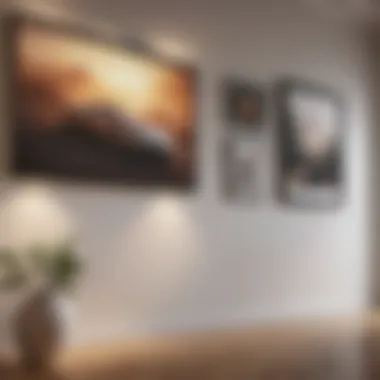
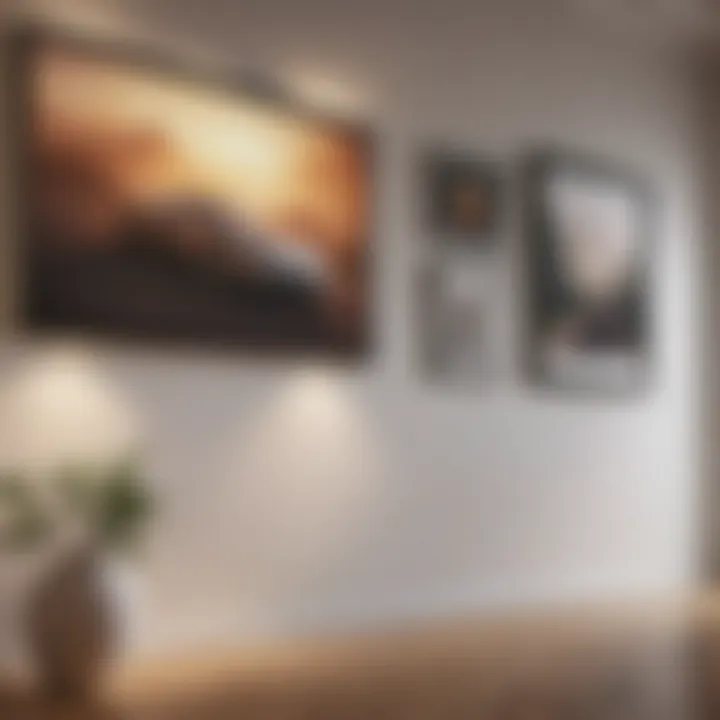
Intro
Hanging pictures is more than just an act of decoration; it is a form of expression that breathes life into the spaces we inhabite. The art of displaying images on walls can significantly alter the mood of a room and reflect the personality of its occupants. Whether one chooses to adorn their living room, bedroom, or office with art, careful consideration is vital. It involves not just the selection of frames and images, but also the methods used to hang them. This article takes a closer look at the best practices for hanging pictures effectively and beautifully.
Understanding the psychological aspects of spatial arrangement can open up possibilities for creativity and sophistication in wall decor. Not everyone knows how to achieve this; thus, the journey from concept to execution is essential. We will also touch upon tools and hardware that facilitate this process.
Here’s what we will cover in this comprehensive guide:
- The impact of well-hung art on interiors.
- A variety of tools and techniques to use.
- Layout planning for visual balance.
- Essential hardware for a secure and lasting display.
- Psychological principles behind spatial arrangements that enhance our experience of space.
By the end, readers should have a thorough understanding of how to approach this task so that their homes reflect their style and taste.
Understanding the Importance of Picture Hanging
Hanging pictures correctly on walls is more than a mere aesthetic exercise. It plays a critical role in defining the visual and emotional landscape of a space. Pictures not only showcase personal taste but are also powerful mediums that convey thoughts and feelings. Properly hung art can elevate the ambiance of a room, drawing the eye and creating focus points. In this section, we will explore various aspects that highlight the significance of effective picture hanging.
Visual Impact of Artwork
The visual impact of artwork cannot be overstated. When placed thoughtfully, pictures can significantly enhance a room's atmosphere. The arrangement and position of art pieces affect how they are perceived. For example, a single large picture can act as a focal point, while multiple smaller pieces can create a narrative. The colors and themes of the artwork should harmonize with the overall decor. When art captures attention in the right context, it can invoke interest and conversation.
Creating Personal Space
Art is inherently personal. It reflects individual experiences, preferences, and memories. By hanging pictures that resonate personally, one creates a unique space that feels inviting and comforting. This personal touch transforms a generic room into a sanctuary. It allows for expressions of identity and leisure, enabling a space to narrate its occupant's story. Think of how a gallery wall adorned with travel memories or family portraits creates a warm, welcoming environment.
Psychological Effects of Art
Art plays a pivotal role in influencing emotions and mental states. Various studies show that well-placed artwork can enhance mood and even boost productivity. The choice of images can evoke feelings of calmness or energy. Nature scenes, for instance, may create a sense of tranquility, while vibrant abstract pieces may energize a space. Understanding the psychological effects of art can guide individuals in selecting pieces that will positively influence their environment. Furthermore, adjusting the arrangement of pictures in line with these effects can greatly enhance one’s experience of a room.
"Art washes away from the soul the dust of everyday life." - Pablo Picasso
By paying attention to these elements of picture hanging, one can create spaces that are visually arresting, personally meaningful, and psychologically beneficial. Each consideration contributes to a cohesive narrative that transforms any wall into a reflection of the values and tastes of those who inhabit the space.
Choosing the Right Location
Choosing where to hang pictures on your walls holds significant value in achieving a harmonious and aesthetically pleasing space. A well-selected location can affect not only the visual dynamics of a room but also the way the occupants interact with the artwork. This section will explore the intricacies of wall space assessment, the critical nature of appropriate lighting, and the overall room aesthetics to help you achieve a refined look in your home.
Assessing Wall Space
Before hanging any pictures, it is essential to assess your available wall space. This involves considering the dimensions of your wall, the existing furniture, and the layout of the room. Measure the wall to understand how much of it is usable for display. Make note of any obstacles, such as windows, doors, or electrical outlets, which may influence picture placement.
- Visual Balance: Ensure that the pictures do not overcrowd the wall space. An excess of small pictures can create a chaotic appearance. Instead, consider larger pieces or thoughtfully arranged groupings that create a balanced visual presence.
- Correct Height: Typically, pictures should be hung at eye level for the best viewing experience, which is around 57 inches from the floor to the center of the art. Adjust this height based on your own stature or the furniture it is near.
Lighting Considerations
Lighting plays a crucial role in the picture hanging process. The way your art is illuminated can drastically affect its visual appeal and emotional impact. Here are some key factors regarding lighting:
- Natural Light: Consider how natural light interacts with your space at different times of day. Avoid placing pictures directly in line with windows if it may cause glare or muted colors.
- Artificial Lighting: Use wall sconces or picture lights to enhance artwork visibility at night. Ensure the light source is directed toward the art without causing harsh shadows or reflections.
- Highlight Key Pieces: If you have a favorite work of art, consider spotlighting it to draw attention. This can create a focal point in the room and enrich the overall atmosphere.
Room Aesthetics
The room's overall aesthetics must be taken into account when determining where to place your pictures. This includes color schemes, furniture styles, and the feeling you want your space to embody.
- Style Cohesion: Ensure that the artwork reflects or complements the style of the room. For instance, modern art might clash in a traditionally furnished space.
- Color Coordination: Take a look at your walls and consider their color. Artwork with colors that harmonize or contrast with the wall can either enhance or detract from the overall design.
- Theme Consistency: If your room has a specific theme, such as nautical or minimalist, the artwork should resonate with that theme to create a cohesive environment.


Choosing the right location for your pictures involves a careful balance of space, lighting, and aesthetics. Mismatched art can disrupt the flow of a room, while harmonious arrangements can elevate the overall design.
By thoughtfully considering these elements in the process of hanging pictures, you can transform plain walls into inviting displays that express personal taste and enhance the beauty of your living space.
Types of Hardware for Hanging Pictures
Understanding the various types of hardware for hanging pictures is crucial for achieving a stable and attractive display. Selecting the right hardware can greatly affect both the safety and aesthetic of your artwork. Different pictures have different weight and dimension characteristics, so the choice of hardware must accommodate these factors. A good fit ensures that the artwork stays in place, enhancing visual appeal without risking damage to the walls or the art piece itself.
Nail and Hammer Techniques
Using nails and a hammer is one of the most traditional methods for hanging pictures. This technique is simple and requires minimal tools.
- Choosing the Right Nail: Select a nail that can support the weight of your picture. For lightweight frames, a standard finishing nail is sufficient. For heavier frames, consider using a larger or more robust nail.
- Placement Tips: Drive the nail into the wall at a slight upward angle. This helps the nail grip better and reduces the chances of the picture falling off.
- Using Multiple Nails: For larger frames, consider using two nails. This distributes the weight more evenly and provides extra stability.
Benefits of Nails:
- Simple and cost-effective.
- Easy to adjust if you want to rearrange your pictures later.
Hooks and Hangers
Hooks and hangers offer versatile options for various picture sizes and weights. This category includes wall hooks, picture hanging strips, and specialized hanging devices.
- Wall Hooks: A hook can be a single or multiple point support. Wall hooks are good for medium to heavy frames.
- Picture Hanging Strips: These are adhesive-backed strips that can hold frames without leaving marks on the wall. They are ideal for renters or those who frequently switch out artwork. Make sure to choose strips that match the frame's weight.
- D-Rings and Sawtooth Hangers: D-rings are attached to the back of the frame, allowing for easy hanging on hooks. Sawtooth hangers offer a secure fit and allow for a quick set up.
Benefits of Hooks and Hangers:
- Provide strong support.
- Easy to install and remove without wall damage.
Adhesive Strips and Tape
Adhesive strips and tape are modern solutions for hanging artwork, particularly in spaces where nails may not be preferable. This method is gaining popularity due to its ease and flexibility.
- Types of Adhesive Products: Brands like Command offer various command strips designed specifically for picture hanging. These strips come in different sizes based on the weight of the frame.
- Surface Compatibility: Ensure the surface is clean and dry before applying the strips. They work best on smooth surfaces and are not suitable for textured walls.
- Adjustability: Many adhesive options allow for repositioning without damage, making them suitable for frequent decor changes.
Benefits of Adhesive Products:
- No tools required.
- Ideal for renters or temporary setups.
Important Note: Always consider the weight and dimensions of your art before choosing a hanging method. The wrong choice can lead to damage of both the art and your walls.
Selecting the right hardware is integral to successfully hanging your pictures. Each method has its own advantages and is suitable for different scenarios. Whether you are using nails, hooks, or adhesive strips, understanding the unique attributes of each can elevate your decor while maintaining safety.
Measuring and Marking
Proper measuring and marking of wall space is a crucial step in the process of hanging pictures. Getting this step right ensures that the final display is not only visually appealing but also strategically placed. Accurately determining where each piece of art will hang plays an integral role in achieving symmetry and balance in your decor. Missing this can lead to a disorganized and chaotic appearance that can detract from the overall experience of the room.
The first essential element of measuring and marking is tool selection. The right tools can significantly impact your accuracy.
Tools Required for Accurate Measurement
- Tape Measure: This is the primary tool for measuring distances. A flexible tape can navigate walls and furniture easily.
- Pencil: A fine pencil allows for light, temporary marks that can be easily erased later.
- Level: This ensures that your artwork is straight, which is vital for a finished look. Using a level also prevents the need for adjustments later.
- Stud Finder: When dealing with heavy frames or large pieces, using a stud finder helps locate wall studs for secure placements.
In addition to these must-have tools, a notepad can be handy to jot down measurements or sketch layouts as needed.
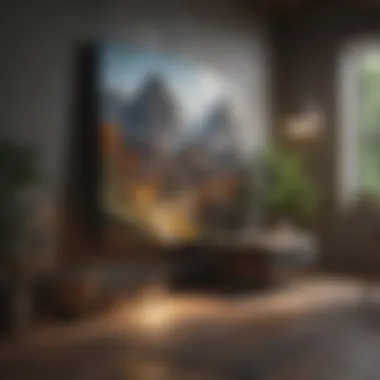
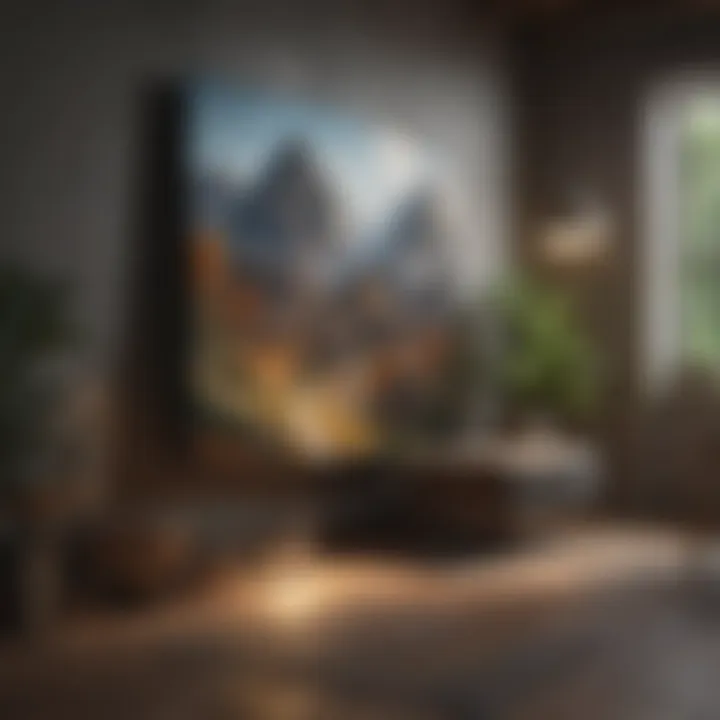
Techniques for Marking Placement
Once you have your tools ready, the next step is to implement effective marking techniques. These practices enhance accuracy and ensure a smoother hanging process.
- Start with a Reference Point: Determine what is the focal point or starting area for your artwork. This could be the center of the wall or an adjacent piece of furniture.
- Mark the Height: Generally, pictures should be hung at eye level. A good rule of thumb is to have the center of the artwork at 57 to 60 inches from the floor. Therefore, if your artwork is, for example, 24 inches tall, you would want to make a mark at 48 to 51 inches from the floor.
- Use a Level Line: Once you have established the initial height, use the level to create a light horizontal line across your wall. This helps you see where the edges of your pictures will align, enabling easier installation.
- Check Spacing: If you're hanging multiple pieces, use spacers or templates. This will keep the distance between artworks consistent. Deviation can make the arrangement look unplanned and haphazard.
Accurate measuring and marking create a framework for the entire hanging process, setting the standard for visual alignment and overall aesthetic.
Measuring and marking are essential to create an effective gallery that reflects your personality and design vision. With the right tools and techniques, achieving a polished and cohesive look for your wall space is much simpler.
Techniques for Hanging Pictures
Understanding the various techniques for hanging pictures is essential for achieving a polished look in any space. The right method can enhance the visual appeal of artworks and make a significant impact on the overall room aesthetics. Moreover, selecting effective hanging techniques can ensure the longevity of the artwork and facilitate easy adjustments when needed. Therefore, exploring these techniques provides substantial advantages for anyone looking to personalize their environment with art.
Grid and Symmetrical Arrangements
Grid and symmetrical arrangements offer a structured approach to displaying artwork. This technique involves positioning frames in a precise manner, often aligning them in a square or rectangular formation. The benefits of such arrangements are numerous. They create a sense of order and balance, which many people find visually pleasing. Having a grid layout can also draw attention and make a focal point out of a specific wall.
To implement a grid arrangement:
- Choose the right frames: Ensure they are similar in size and style.
- Space evenly: Maintain consistent gaps between each piece. A common recommendation is to leave 2 to 4 inches of space, but this can vary based on personal preference and the size of the pieces.
- Start with a central anchor piece: This helps in determining the dimensions of the entire grid and shapes the surrounding layout.
This method not only showcases the art effectively but also simplifies future changes. When you want to rotate pieces or replace artworks, the symmetrical nature can make it easier to adjust the gapping and layout without significant disruption.
Gallery Walls
Gallery walls are a dynamic way to showcase multiple pieces of artwork and are increasingly popular in contemporary decor. This technique allows for a more eclectic feel. Unlike grid arrangements, gallery walls emphasize individuality and can include a mix of sizes, styles, and frames. The key to a successful gallery wall lies in its planning.
Here are some considerations:
- Theme selection: Determine a cohesive theme or color palette to create unity among diverse pieces.
- Layout design: Before hanging, lay out the pieces on the floor to visualize the arrangement. This saves time and avoids unnecessary holes in the walls.
- Optimal spacing: Vary the spacing between frames to create visual interest while maintaining a general structure. The distances can range from 1 to 6 inches based on the visual weight of each art piece.
This approach enables personal expression and storytelling. A carefully curated gallery wall can serve as a conversation starter and reflects individual taste and experiences.
Using Ledges and Shelves
Ledges and shelves are innovative solutions for hanging pictures without committing to permanent placements. They offer flexibility, allowing for easy rearrangement of art. This method can work wonders for creating fluidity in decor, especially if styles or mood shifts over time.
Advantages of using ledges and shelves include:
- Easy customization: Rearranging art pieces requires no tools, making it simple to refresh the display.
- Layered display: You can mix frames and incorporate decorative items such as plants or books in the layout, enriching the visual narrative.
- Considerate of wall decor: If you are hesitant about drilling holes into walls, this option becomes practical.
When setting up ledges, consider:
- Height placement: Position shelves at eye level to create a harmonious view.
- Depth consideration: Ensure shelves are deep enough to hold frames securely without risk of falling.
For those who appreciate art but might change their preferences frequently, this technique brings versatility while still allowing creativity.
Considerations for Different Wall Materials
When hanging pictures, it is vital to consider the type of wall material you are dealing with. Each material has unique characteristics that affect the choice of hardware and techniques used. Understanding these factors not only ensures that your artwork is securely mounted but also preserves the integrity of the wall itself.
Hanging on Drywall
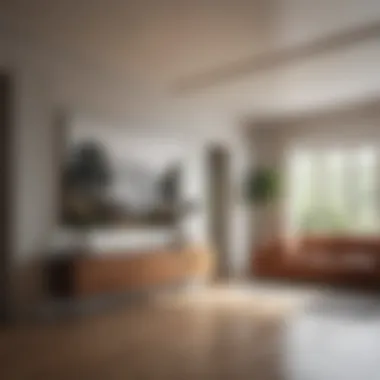
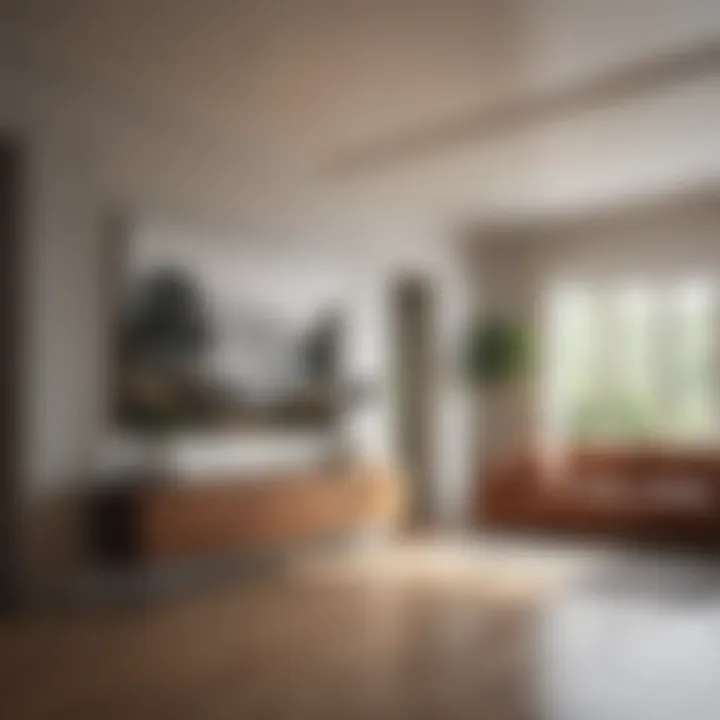
Drywall is a common wall material found in many homes. It is composed of gypsum plaster sandwiched between two layers of heavy paper. When hanging pictures on drywall, it’s important to ensure that the weight of the artwork does not exceed the support capability of the hardware used.
Utilizing anchors, such as toggle bolts or wall plugs, is often necessary for heavier pieces. Here are some tips for hanging on drywall:
- Use appropriate anchors: For pictures weighing over 10 pounds, always opt for heavy-duty wall anchors.
- Stud finder: Locate the wooden framing within the wall and mount alongside the studs whenever possible.
- Spacing: Maintain uniform spacing between multiple pieces to achieve a visually pleasing display.
Concrete and Brick Walls
Concrete and brick walls present a different challenge. These materials are much denser than drywall, requiring specific tools and techniques for effective hanging.
To mount paintings or photographs on these surfaces, follow these guidelines:
- Drilling: A masonry drill bit is essential when creating holes in concrete or brick. Regular drill bits will not suffice.
- Concrect screws or anchors: Use masonry screws or expansion anchors to securely hold your artwork. This is important, as typical drywall screws won’t work in these materials.
Consider using a hammer drill for a more efficient drilling process, as it combines rotation and hammering, making it easier to penetrate the hard surface.
Decorative Finishes and Specialty Surfaces
Decorative finishes, such as wallpaper, textured paint, or specialty coatings, add aesthetic value to your walls. However, these surfaces may require careful consideration to avoid damage.
Here are some points to keep in mind:
- Adhesive options: For delicate surfaces, consider using adhesive strips that are designed for easy removability. These types of products minimize damage when the artwork is taken down.
- Weight distribution: Ensure that the weight of your artwork is evenly distributed to avoid peeling or damaging the surface beneath.
- Test patches: Prior to hanging, conduct a test with the adhesive or hardware in a less visible spot. This can prevent unwanted surprises when your final piece is hung.
In summary, understanding the type of wall material is fundamental to achieving a successful hanging experience. Risking damage to walls or losing artwork can be avoided with proper consideration and technique.
By following these guidelines, homeowners can effectively hang pictures on a variety of wall materials, ensuring a stable and aesthetically pleasing display.
Maintenance and Adjustment of Artwork
Maintaining and adjusting artwork is crucial for preserving both its visual impact and longevity. Over time, pictures can collect dust, be affected by changes in light, and require repositioning to maintain their aesthetic value. Understanding how to care for your artwork ensures that it continues to enhance your living space effectively. Regular upkeep not only involves cleaning but also involves adaptations based on seasonal shifts and light changes. These elements elevate the quality of interior decoration and provide an ongoing connection to the art.
Regular Cleaning and Upkeep
Artwork can quickly gather dust and allergens, which may dull its appearance. Ongoing cleaning is essential to keep art looking fresh and vibrant. Here are some basic steps to maintain your artwork:
- Dusting: Use a soft, lint-free cloth or a microfiber cloth for routine dusting. For framed pieces, carefully wipe the frame, glass, and edges to remove any dust buildup. Avoid using harsh chemicals or abrasive cleaners that can damage the finish.
- Handling: Always handle artwork with care. Use clean hands or wear gloves to prevent oils and dirt from damaging the surface. If you're moving artwork, keep it upright and protect it with bubble wrap.
- Storage: When storing artwork, maintain a climate-controlled environment. Avoid damp areas to prevent mold and mildew development. Use archival materials for additional protection.
Regular cleaning extends the life of artwork and prevents damage that could require costly restoration.
Adjusting for Light and Seasons
Light exposure significantly impacts artwork over time. Sunlight and artificial lights can cause fading and discoloration. Adjustments based on seasonal changes can help mitigate these issues:
- Rotate Positions: Every few months, consider rotating artwork. This method can prevent uneven fading in pieces exposed to constant light in one area of the room.
- Use UV-Filtering Glass: When framing, use glass that filters out harmful UV rays. This offers protection against fading while still allowing the brightness of the artwork to shine through.
- Consider Seasonal Lighting: During different times of year, natural light can change dramatically. Adjust the positioning of artwork in response to seasonal sunlight to minimize damage while maximizing aesthetic appeal.
Adjusting for light will not only keep your artwork looking its best but also ensures that it remains a point of enjoyment in your home.
Understanding maintenance and adjustment emphasizes the significance of caring for your art. Investing time in these practices ensures that each piece continues to inspire and please for many years.
Final Thoughts on Hanging Pictures
Hanging pictures is more than just a practical task; it creates an atmosphere, defines a space, and expresses personality. The final thoughts on this subject center on refining one’s approach to both aesthetics and functionality. Picture hanging serves as a reflection of individual style, while also contributing positively to one's living environment.
Personalizing Spaces with Art
Art is a powerful element in personalizing spaces. Selecting pieces that resonate with you brings warmth and character to a room. Whether it's a family portrait or abstract painting, each artwork conveys a story. This connection is essential for transforming a house into a home. Consider the scale and color of art in relation to the surrounding decor. It should complement rather than clash with existing elements. Using different mediums—paintings, photographs, or mixed media—can create visual interest.
- Choose Meaningful Art: Select pieces that reflect your journey or interests. This emotional connection adds depth to space.
- Balance is Key: Ensure artwork is proportionate to wall size. Large pieces can serve as focal points, while smaller works can enhance a gallery-style arrangement.



